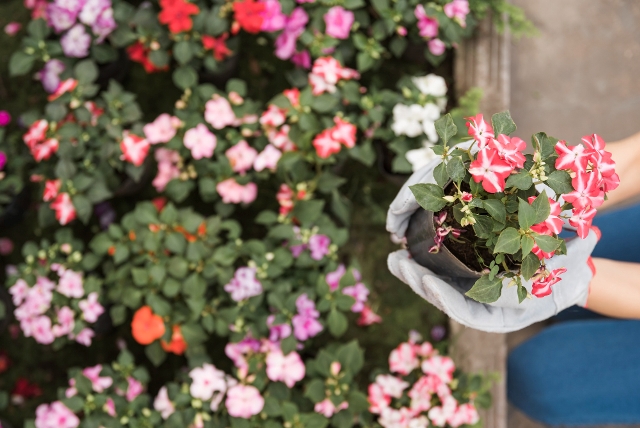Flower gardening is an art that knows no bounds, even in the constraints of small balcony spaces. As urban living becomes more prevalent, the desire to connect with nature has led to the popularity of balcony gardening. In this article, we will explore the ins and outs of transforming your compact balcony into a vibrant floral oasis.
Choosing the Right Flowers
Consideration of climate and balcony conditions
When selecting flowers for your balcony garden, it’s crucial to consider your local climate and the specific conditions of your balcony. Certain flowers thrive in different climates, and understanding your balcony’s microclimate will guide your choices.
Low-maintenance flower options
For beginners or those with limited time for upkeep, opting for low-maintenance flowers is a wise decision. Hardy perennials and drought-resistant annuals are excellent choices that add beauty without demanding excessive care.
Color coordination for aesthetic appeal
Creating an appealing visual display involves thoughtful color coordination. Understanding the color wheel and selecting flowers that complement each other will elevate the overall aesthetic of your balcony garden.
Selecting Suitable Containers
Importance of proper drainage
The health of your balcony garden starts with proper drainage. Choosing containers with drainage holes prevents waterlogging, ensuring the well-being of your flowers.
Ideal container materials
Selecting the right materials for your containers is essential. Lightweight and durable materials, such as plastic or composite, are practical choices for balcony gardening.
Space-efficient container options
Maximizing space is key in small balcony gardening. Consider vertical planters, railing boxes, and hanging pots to optimize every inch of your balcony.
Soil and Fertilization
Importance of quality soil
Quality soil is the foundation of a thriving balcony garden. Invest in nutrient-rich soil to provide your flowers with the essential elements they need to flourish.
Fertilization tips for balcony flowers
Balcony flowers may require additional nutrients due to limited soil volume. Choose a suitable fertilizer and follow a consistent schedule to keep your blooms healthy and vibrant.
Watering Techniques
Balancing hydration without waterlogging
Finding the right balance in watering is crucial for balcony flowers. Avoid waterlogging by allowing the soil to dry slightly between watering sessions.
Tools and methods for efficient watering
In small spaces, precision matters. Utilize watering cans with narrow spouts or consider a drip irrigation system to ensure each plant receives the right amount of water.
Sunlight Considerations
Understanding sunlight requirements
Different flowers have varying sunlight needs. Assess your balcony’s sunlight patterns and choose flowers that thrive in the available conditions, whether in full sun, partial shade, or shade.
Adjusting for balcony shade and sunlight patterns
For balconies with limited sunlight, choose shade-tolerant flowers and strategically place containers to optimize sunlight exposure throughout the day.
Arranging Flowers Creatively
Utilizing vertical space
In small balcony gardens, vertical space is an untapped resource. Use wall-mounted planters or shelves to showcase flowers, creating a visually appealing vertical garden.
Incorporating hanging planters
Hanging planters not only save floor space but also add a dynamic visual element to your balcony garden. Choose trailing flowers for a cascading effect.
Mixing and matching flower varieties for a vibrant look
Create visual interest by mixing and matching different flower varieties. Combine varying heights, colors, and textures to achieve a harmonious and vibrant display.
Pest Management on Balconies
Common pests in balcony gardening
Pests can be a challenge in any garden, and balconies are no exception. Identify common pests like aphids and spider mites early on and take prompt action to prevent infestations.
Natural and eco-friendly pest control methods
Embrace natural pest control methods to protect your balcony garden and the environment. Neem oil, companion planting, and introducing beneficial insects are effective eco-friendly options.
Seasonal Care and Maintenance
Tailoring care routines for different seasons
Adapt your care routines to the changing seasons. Consider temperature fluctuations, sunlight duration, and precipitation levels to provide optimal care for your balcony flowers year-round.
Pruning and deadheading techniques
Regular pruning and deadheading promote healthy growth and extend the flowering period. Remove spent blooms and trim unruly branches to maintain the overall shape and appearance of your balcony garden.
Balcony Garden Accessories
Adding decorative elements
Elevate the aesthetics of your balcony garden with decorative elements. Consider incorporating garden art, wind chimes, or outdoor lighting to create a cozy and inviting atmosphere.
Practical accessories for balcony flower gardening
Invest in practical accessories like watering systems, lightweight garden tools, and weather-resistant furniture to enhance the functionality of your balcony garden.
Benefits of Balcony Flower Gardening
Mental health benefits
Balcony flower gardening offers a therapeutic escape from the hustle and bustle of urban life. The act of nurturing plants can reduce stress and improve mental well-being.
Positive impact on the environment
Even in small spaces, balcony gardens contribute to environmental health. Plants absorb carbon dioxide, release oxygen, and provide habitats for beneficial insects, fostering a greener urban environment.
Community Balcony Gardening
Collaborative gardening initiatives
Connect with neighbors to create a sense of community through balcony gardening. Collaborative initiatives, such as shared plant swaps or joint maintenance efforts, can enhance the gardening experience.
Sharing experiences and tips with neighbors
Exchange gardening experiences and tips with neighbors to foster a supportive community. Learn from each other’s successes and challenges, creating a shared knowledge base for flourishing balcony gardens.
Overcoming Challenges
Limited space challenges
Address the challenges of limited space by embracing vertical gardening, compact containers, and creative arrangement strategies.
Weather and environmental challenges
Be prepared for weather and environmental challenges by selecting hardy flowers, monitoring local weather forecasts, and providing appropriate protection during extreme conditions.
FAQs
Small balconies offer unique opportunities for creative gardening. Utilize vertical space and choose compact plant varieties for a thriving garden.
Implement natural pest control methods such as neem oil, companion planting, and introducing beneficial insects. Regularly inspect your plants for early pest detection.
For shaded balconies, consider flowers like impatiens, begonias, and ferns that thrive in low-light conditions. Ensure they receive filtered sunlight for optimal growth.
The frequency of watering depends on factors like climate and plant type. Allow the soil to dry slightly between waterings, and adjust based on environmental conditions.
Join online gardening forums or local community groups. Attend gardening events or organize plant swaps to connect with like-minded individuals in your neighborhood.
Conclusion
Balcony flower gardening is not just about cultivating plants; it’s about creating a personal sanctuary in the midst of urban living. By carefully choosing flowers, containers, and accessories, and overcoming challenges with creativity, you can turn your small balcony into a blooming haven. Embrace the benefits, connect with your community, and let the beauty of blossoming balconies enhance your daily life.


